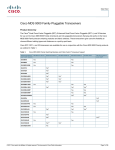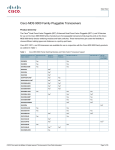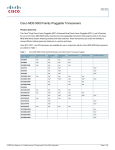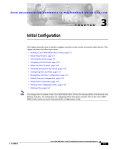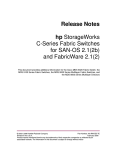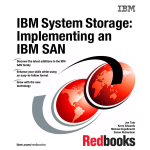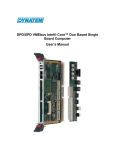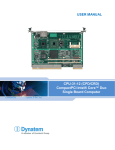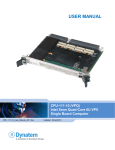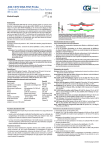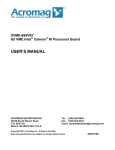Download Cisco Systems OL-7765-04 User's Manual
Transcript
Se n d d o c u m e n t a t i o n c o m m e n t s t o m d s f e e d b a ck - d o c @ c i s c o . c o m C H A P T E R 2 Initial Switch Configuration This chapter provides instructions for setting up the hardware, connecting to the console port, and initially configuring the switch from the CLI. This chapter includes the following sections: • Preparing for Network Connections, page 2-1 • Connecting the Console Port, page 2-2 • Connecting the 10/100 Ethernet Management Port, page 2-4 • Using the Switch Setup Utility, page 2-5 • Verifying the Module Status, page 2-9 Preparing for Network Connections When preparing your site for network connections to the Cisco MDS 9000 switch, consider the following: • Cabling required for each interface type • Distance limitations for each signal type • Additional interface equipment needed Before installing a device, have all additional external equipment and cables available. Configuration Prerequisites Before you configure a switch in the Cisco MDS 9000 Family for the first time, make sure you have the following information: • Administrator password. • Switch name—This name is also used as your switch prompt. • IP address for the switch’s management interface. • Subnet mask for the switch's management interface. • IP address of the default gateway. Cisco MDS 9000 Family Fabric Manager Quick Configuration Guide OL-7765-04 2-1 Chapter 2 Initial Switch Configuration Connecting the Console Port Se n d d o c u m e n t a t i o n c o m m e n t s t o m d s f e e d b a ck - d o c @ c i s c o . c o m Connecting the Console Port This section describes how to connect the RS-232 console port to a PC. The console port allows you to perform the following functions: • Configure the switch from the CLI. • Monitor network statistics and errors. • Configure SNMP agent parameters. • Manage downloading software updates (through the Ethernet management interface) or distributing Flash memory software images to attached devices. Figure 2-1, Figure 2-2, Figure 2-3 and Figure 2-4 show the console port and management port located on a Cisco MDS 9500 series supervisor-1 module, Cisco MDS 9500 series supervisor-2 module, a Cisco MDS 9200 series supervisor module, and Cisco MDS 9100 series supervisor module. Figure 2-1 Cisco MDS 9500 Series Supervisor Module 2 140573 1 1 Console port 2 MGMT 10/100 Ethernet port (with integrated link and activity LEDs) Figure 2-2 Cisco MDS 9500 Series Supervisor-2 Module 154318 2 1 1 Status, System, Active, and Pwr Mgmt LEDs 4 MGMT 10/100/1000 Ethernet port (with integrated Link and Activity LEDs) Cisco MDS 9000 Family Fabric Manager Quick Configuration Guide 2-2 OL-7765-04 Chapter 2 Initial Switch Configuration Connecting the Console Port Se n d d o c u m e n t a t i o n c o m m e n t s t o m d s f e e d b a ck - d o c @ c i s c o . c o m Connecting the Console Cable to a Cisco MDS 9200 Series Switch S SY ST EM ST AT U MDS 9216i RE SE T 1 CONSOLE 2 MGMT 10/100 COM1 140571 Figure 2-3 1 Console port 2 MGMT 10/100 Ethernet port (with integrated link and activity LEDs) Figure 2-4 2 140572 1 Connecting the Console Cable to a Cisco MDS 9100 Series Switch 1 Console port 2 MGMT 10/100 Ethernet port (with integrated link and activity LEDs) Cisco MDS 9000 Family Fabric Manager Quick Configuration Guide OL-7765-04 2-3 Chapter 2 Initial Switch Configuration Connecting the 10/100 Ethernet Management Port Se n d d o c u m e n t a t i o n c o m m e n t s t o m d s f e e d b a ck - d o c @ c i s c o . c o m Connecting the Console Port to a PC You can connect the console port to a PC serial port for local administrative access to the Cisco MDS 9000 Family switch. Note The PC must support VT100 terminal emulation. The terminal emulation software—frequently a PC application such as HyperTerminal Plus—makes communication between the Cisco MDS 9000 Family switch and your PC possible during setup and configuration. To connect the console port to a PC, follow these steps: Step 1 Configure the baud rate and character format of the PC terminal emulation program to match the following management port default characteristics: • 9600 baud • 8 data bits • 1 stop bit • No parity Step 2 Connect the supplied RJ-45 to DB-9 female adapter or RJ-45 to DB-25 female adapter (depending on your PC connection) to the PC serial port. Step 3 Connect one end of the supplied console cable (a rollover RJ-45 to RJ-45 cable) to the console port. (See Figure 2-4.) Connect the other end to the RJ-45 to DB-9 (or RJ-45 to DB-25) adapter at the PC serial port. Note If you are using a Cisco MDS 9500 Series switch that has multiple supervisor modules, connect the console port to the active supervisor module. The active supervisor is the module with the green Active LED. Connecting the 10/100 Ethernet Management Port The autosensing 10/100 Ethernet management port is located on the left side of the front panel (labeled 10/100 MGMT), to the right of the console port (see Figure 2-1, Figure 2-3, and Figure 2-4). This port is used for out-of-band management of the Cisco MDS 9000 Family switches. Make sure to connect the Ethernet management ports of both supervisor modules on a MDS 9500 Series switch. Even though there are two Ethernet connections, only one management IP address is required for a switch with dual supervisor modules. Tip The two Ethernet connections should be connected to ports in different slots on the same LAN switch, or the connections should be split between two different LAN switches. Cisco MDS 9000 Family Fabric Manager Quick Configuration Guide 2-4 OL-7765-04 Chapter 2 Initial Switch Configuration Connecting to the MGMT 10/100/1000 Ethernet Port Se n d d o c u m e n t a t i o n c o m m e n t s t o m d s f e e d b a ck - d o c @ c i s c o . c o m If only the active supervisor module is connected to the LAN and an event occurs that causes a system switchover (such as a software upgrade), the switch becomes unmanageable through the Ethernet port after the active supervisor module reboots and the standby supervisor module becomes the active supervisor module. Use modular, RJ-45 cables to connect the 10/100 Ethernet management port to external hubs and switches. Connecting to the MGMT 10/100/1000 Ethernet Port The Supervisor-2 module supports an autosensing MGMT 10/100/1000 Ethernet port (labeled “MGMT 10/100/1000”) and has an RJ-45 interface. You can use this port to access and manage the switch by IP address, such as through Cisco Fabric Manager. Use a modular, RJ-45, straight-through UTP cable to connect the MGMT 10/100/1000 Ethernet port to an Ethernet switch port or hub. Using the Switch Setup Utility The switch setup utility helps you configure the switch through the CLI. To configure the switch, follow these steps: Step 1 Verify the following physical connections for the new Cisco MDS 9000 Family switch (see Figure 2-4): • The console port is physically connected to a computer terminal (or terminal server). • The management 10/100 Ethernet port (mgmt0) is connected to an external hub, switch, or router. Refer to the hardware installation guide for your specific product. Tip Save the host ID information for future use (for example, to enable licensed features). The host ID information is provided in the Proof of Purchase document that accompanies the switch. Step 2 Verify that the default console port parameters are identical to those parameters of the computer terminal (or terminal server) attached to the switch console port (see the “Connecting the Console Port to a PC” section on page 2-4). Step 3 Power on the switch. The switch boots automatically. Note If the switch boots to the loader> or switch(boot) prompt, contact your storage vendor support organization for technical assistance. After powering on the switch, you see the following output: General Software Firmbase[r] SMM Kernel 1.1.1002 Aug General Software, Inc. 6 2003 22:19:14 Copyright (C) 2002 Firmbase initialized. 00000589K Low Memory Passed 01042304K Ext Memory Passed Wait..... Cisco MDS 9000 Family Fabric Manager Quick Configuration Guide OL-7765-04 2-5 Chapter 2 Initial Switch Configuration Using the Switch Setup Utility Se n d d o c u m e n t a t i o n c o m m e n t s t o m d s f e e d b a ck - d o c @ c i s c o . c o m General Software Pentium III Embedded BIOS 2000 (tm) Revision 1.1.(0) (C) 2002 General Software, Inc.ware, Inc. Pentium III-1.1-6E69-AA6E +------------------------------------------------------------------------------+ | System BIOS Configuration, (C) 2002 General Software, Inc. | +---------------------------------------+--------------------------------------+ | System CPU : Pentium III | Low Memory : 630KB | | Coprocessor : Enabled | Extended Memory : 1018MB | | Embedded BIOS Date : 10/24/03 | ROM Shadowing : Enabled | +---------------------------------------+--------------------------------------+ Loader Loading stage1.5. Loader loading, please wait... Auto booting bootflash:/m9500-sf1ek9-kickstart-mz.2.1.1a.bin bootflash:/m9500-s f1ek9-mz.2.1.1a.bin... Booting kickstart image: bootflash:/m9500-sf1ek9-kickstart-mz.2.1.1a.bin...................Image verification OK Starting kernel... INIT: version 2.78 booting Checking all filesystems..... done. Loading system software Uncompressing system image: bootflash:/m9500-sf1ek9-mz.2.1.1a.bin CCCCCCCCCCCCCCCCCCCCCCCCCCCCCCCCCCCCCCCCCCCCCCCCCCCCCCCCCCCCCCCCCCCCCCCCCCCCCCCCCCCCCCCCCC INIT: Entering runlevel: 3 Step 4 Make sure you enter the password you wish to assign for the admin username. ---- System Admin Account Setup ---Enter the password for "admin": Step 5 Tip If you create a password that is short and easy to decipher, then your password is rejected. Be sure to configure a strong password. Passwords are case-sensitive. You must explicitly configure a password that meets the requirements listed in the “Configuring User Accounts” section in the Cisco MDS 9000 Family CLI Quick Configuration Guide. Note If you are running the switch setup utility for the first-time, it starts automatically. If this is not the first-time configuration, you are required to enter setup at the system prompt. Note If you do not wish to answer a previously configured question, or if you wish to skip answers to any questions, press Enter. If a default answer is not available (for example, the switch name), the switch uses what was previously configured and skips to the next question. Enter yes to enter setup mode. This setup utility will guide you through the basic configuration of the system. Setup configures only enough connectivity for management of the system. *Note: setup is mainly used for configuring the system initially, when no configuration is present. So setup always assumes system defaults and not the current system configuration values. Press Enter at anytime to skip a dialog. Use ctrl-c at anytime to skip the remaining dialogs. Cisco MDS 9000 Family Fabric Manager Quick Configuration Guide 2-6 OL-7765-04 Chapter 2 Initial Switch Configuration Using the Switch Setup Utility Se n d d o c u m e n t a t i o n c o m m e n t s t o m d s f e e d b a ck - d o c @ c i s c o . c o m Would you like to enter the basic configuration dialog (yes/no): yes The switch setup utility guides you through the basic configuration process. Press Ctrl-C at any prompt to end the configuration process. Step 6 Enter no (no is the default) to not create any additional accounts. Create another login account (yes/no) [n]: no Step 7 Enter no (no is the default) to not configure any read-only SNMP community strings. Configure read-only SNMP community string (yes/no) [n]: no Step 8 Enter no (no is the default) to not configure any read-write SNMP community strings. Configure read-write SNMP community string (yes/no) [n]: no Step 9 Enter a name for the switch. Note The switch name is limited to 32 alphanumeric characters. The default is switch. Enter the switch name: switch_name Step 10 Enter yes (yes is the default) to configure the out-of-band management configuration. Continue with Out-of-band (mgmt0) management configuration? (yes/no) [y]: yes a. Enter the IP address for the mgmt0 interface. Mgmt0 IP address : mgmt_IP_address b. Enter the netmask for the mgmt0 interface in the xxx.xxx.xxx.xxx format. Mgmt0 IP netmask : xxx.xxx.xxx.xxx Step 11 Enter yes (yes is the default) to configure the default gateway (recommended). Configure the default-gateway: (yes/no) [y]: yes Step 12 Enter the default gateway IP address. IP address of the default-gateway: default_gateway Step 13 Enter no (no is the default) to configure advanced IP options such as in-band management, static routes, default network, DNS, and domain name. Configure Advanced IP options (yes/no)? [n]: no Step 14 Enter yes (yes is the default) to enable Telnet service. Enable the telnet service? (yes/no) [y]: yes Step 15 Enter no (no is the default) to not enable the SSH service. Enable the ssh service? (yes/no) [n]: no Step 16 Enter no (no is the default) to not configure the NTP server. Configure the ntp server? (yes/no) [n]: no Step 17 Enter noshut (shut is the default) to configure the default switch port interface to the noshut state. Configure default switchport interface state (shut/noshut) [shut]: noshut Cisco MDS 9000 Family Fabric Manager Quick Configuration Guide OL-7765-04 2-7 Chapter 2 Initial Switch Configuration Using the Switch Setup Utility Se n d d o c u m e n t a t i o n c o m m e n t s t o m d s f e e d b a ck - d o c @ c i s c o . c o m Step 18 Enter on (on is the default) to configure the switch port trunk mode. Configure default switchport trunk mode (on/off/auto) [on]: on Step 19 Enter deny (deny is the default) to configure a default zone policy configuration. Configure default zone policy (permit/deny) [deny]: deny This step denies traffic flow for all members of the default zone. Step 20 Enter yes (no is the default) to enable a full zone set distribution (refer to the Cisco MDS 9000 Family CLI Quick Configuration Guide). Enable full zoneset distribution (yes/no) [n]: yes You see the new configuration. Review and edit the configuration that you have just entered. Step 21 Enter no (no is the default) if you are satisfied with the configuration. The following configuration will be applied: switchname switch_name interface mgmt0 ip address mgmt_IP_address subnetmask mgmt0_ip_netmask no shutdown ip default-gateway default_gateway telnet server enable no ssh server enable no system default switchport shutdown system default switchport trunk mode on no zone default-zone permit vsan 1-4093 zoneset distribute full vsan 1-4093 Would you like to edit the configuration? (yes/no) [n]: no Step 22 Enter yes (yes is the default) to use and save this configuration. Use this configuration and save it? (yes/no) [y]: yes Caution If you do not save the configuration at this point, your changes will not be updated the next time that the switch is rebooted. Type yes to save the new configuration to ensure that the kickstart and system images are also automatically configured. Cisco MDS 9000 Family Fabric Manager Quick Configuration Guide 2-8 OL-7765-04 Chapter 2 Initial Switch Configuration Verifying the Module Status Se n d d o c u m e n t a t i o n c o m m e n t s t o m d s f e e d b a ck - d o c @ c i s c o . c o m Verifying the Module Status Before you proceed with further configuration of the switch, ensure that the modules in the chassis are functioning as designed. To verify the status of a module at any time, issue the show module command. All the hardware that was physically installed should be displayed. A sample output of the show module command follows: switch# show module Mod Ports Module-Type --- ----- -------------------------------2 32 1/2 Gbps FC Module 3 16 1/2 Gbps FC Module 4 8 IP Storage Services Module 5 0 Supervisor/Fabric-1 6 0 Supervisor/Fabric-1 7 0 Caching Services Module 9 32 Advanced Services Module Mod --2 3 4 5 6 7 9 Sw ----------2.1(1a) 2.1(1a) 2.1(1a) 2.1(1a) 2.1(1a) 2.1(1a) 2.1(1a) Mod -------7 7 9 Mod --2 3 4 5 6 7 9 Hw -----1.1 3.0 4.0 4.0 4.0 0.702 0.502 Model -----------------DS-X9032 DS-X9016 DS-X9308-SMIP DS-X9530-SF1-K9 DS-X9530-SF1-K9 DS-X9560-SMAP DS-X9032-SMV Status -----------ok ok ok active * ha-standby ok ok World-Wide-Name(s) (WWN) -------------------------------------------------20:41:00:05:30:00:86:9e to 20:60:00:05:30:00:86:9e 20:81:00:05:30:00:86:9e to 20:90:00:05:30:00:86:9e 20:c1:00:05:30:00:86:9e to 20:c8:00:05:30:00:86:9e ---22:01:00:05:30:00:86:9e to 22:20:00:05:30:00:86:9e Application Image Description ----------------------------svc-node1 svc-node2 SSI linecard image MAC-Address(es) -------------------------------------00-0c-30-d9-eb-60 to 00-0c-30-d9-eb-64 00-0c-30-0d-27-54 to 00-0c-30-0d-27-58 00-0c-30-da-92-88 to 00-0c-30-da-92-94 00-0c-30-d9-dc-d0 to 00-0c-30-d9-dc-d4 00-0c-30-d9-ef-80 to 00-0c-30-d9-ef-84 00-0d-bc-2f-bc-b8 to 00-0d-bc-2f-bd-3c 00-05-30-00-ad-4e to 00-05-30-00-ad-52 Application Image Version ------------------------1.3(5m) 1.3(5m) 2.1(1) Serial-Num ---------JAB074704EJ JAB074004RR JAB075204ZN JAB074504RC JAB0747055Y JAB073907DK JAB070605QV * this terminal session Note If you do not see all the installed hardware, contact your storage vendor support organization for further assistance. Cisco MDS 9000 Family Fabric Manager Quick Configuration Guide OL-7765-04 2-9 Chapter 2 Initial Switch Configuration Verifying the Module Status Se n d d o c u m e n t a t i o n c o m m e n t s t o m d s f e e d b a ck - d o c @ c i s c o . c o m Cisco MDS 9000 Family Fabric Manager Quick Configuration Guide 2-10 OL-7765-04











